Jia Li
Pretrained Battery Transformer (PBT): A battery life prediction foundation model
Dec 23, 2025
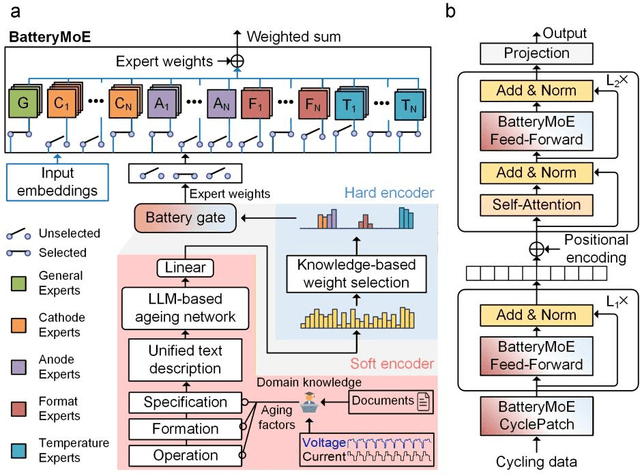
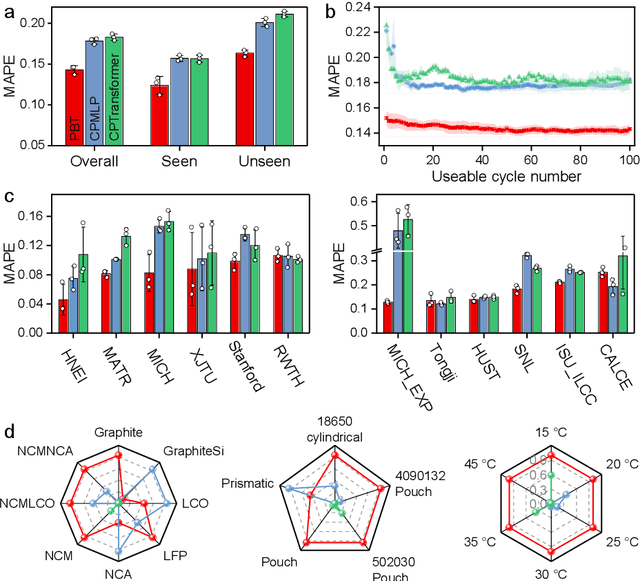
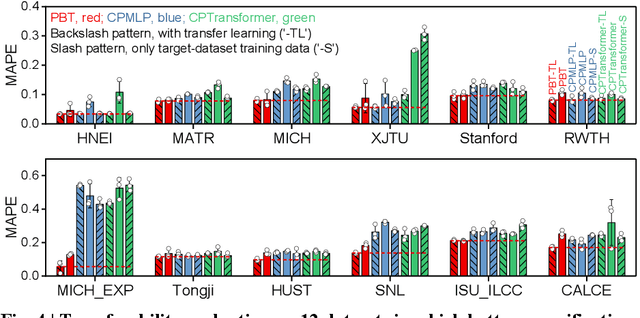
Abstract:Early prediction of battery cycle life is essential for accelerating battery research, manufacturing, and deployment. Although machine learning methods have shown encouraging results, progress is hindered by data scarcity and heterogeneity arising from diverse aging conditions. In other fields, foundation models (FMs) trained on diverse datasets have achieved broad generalization through transfer learning, but no FMs have been reported for battery cycle life prediction yet. Here we present the Pretrained Battery Transformer (PBT), the first FM for battery life prediction, developed through domain-knowledge-encoded mixture-of-expert layers. Validated on the largest public battery life database, PBT learns transferable representations from 13 lithium-ion battery datasets, outperforming existing models by an average of 19.8%. With transfer learning, PBT achieves state-of-the-art performance across 15 diverse datasets encompassing various operating conditions, formation protocols, and chemistries. This work establishes a foundation model pathway for battery lifetime prediction, paving the way toward universal battery lifetime prediction systems.
Cluster-Based Generalized Additive Models Informed by Random Fourier Features
Dec 22, 2025Abstract:Explainable machine learning aims to strike a balance between prediction accuracy and model transparency, particularly in settings where black-box predictive models, such as deep neural networks or kernel-based methods, achieve strong empirical performance but remain difficult to interpret. This work introduces a mixture of generalized additive models (GAMs) in which random Fourier feature (RFF) representations are leveraged to uncover locally adaptive structure in the data. In the proposed method, an RFF-based embedding is first learned and then compressed via principal component analysis. The resulting low-dimensional representations are used to perform soft clustering of the data through a Gaussian mixture model. These cluster assignments are then applied to construct a mixture-of-GAMs framework, where each local GAM captures nonlinear effects through interpretable univariate smooth functions. Numerical experiments on real-world regression benchmarks, including the California Housing, NASA Airfoil Self-Noise, and Bike Sharing datasets, demonstrate improved predictive performance relative to classical interpretable models. Overall, this construction provides a principled approach for integrating representation learning with transparent statistical modeling.
DEER: Draft with Diffusion, Verify with Autoregressive Models
Dec 17, 2025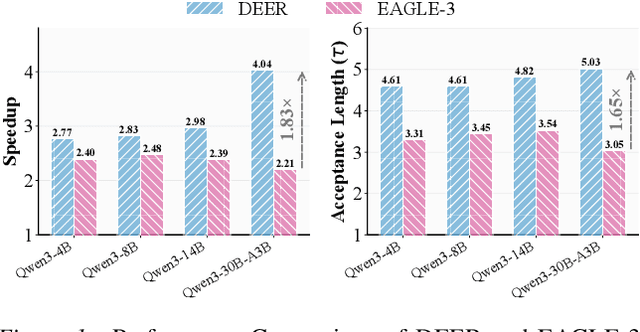
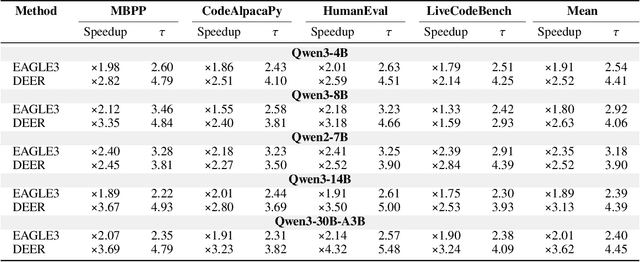
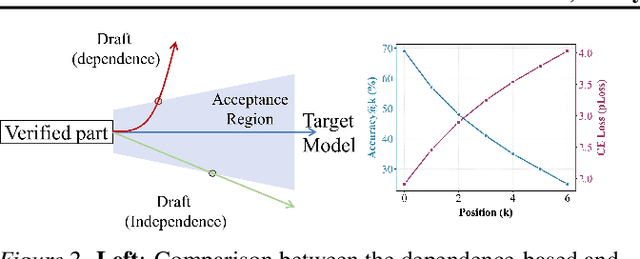
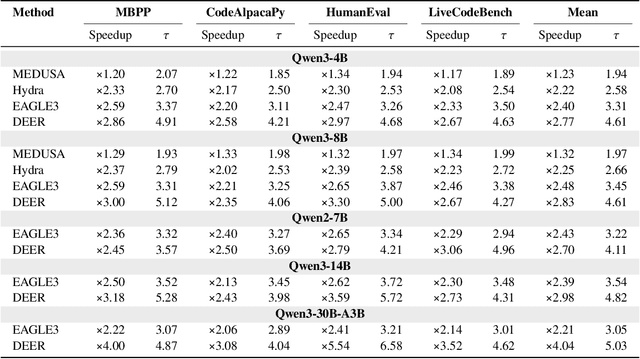
Abstract:Efficiency, as a critical practical challenge for LLM-driven agentic and reasoning systems, is increasingly constrained by the inherent latency of autoregressive (AR) decoding. Speculative decoding mitigates this cost through a draft-verify scheme, yet existing approaches rely on AR draft models (a.k.a., drafters), which introduce two fundamental issues: (1) step-wise uncertainty accumulation leads to a progressive collapse of trust between the target model and the drafter, and (2) inherently sequential decoding of AR drafters. Together, these factors cause limited speedups. In this paper, we show that a diffusion large language model (dLLM) drafters can naturally overcome these issues through its fundamentally different probabilistic modeling and efficient parallel decoding strategy. Building on this insight, we introduce DEER, an efficient speculative decoding framework that drafts with diffusion and verifies with AR models. To enable high-quality drafting, DEER employs a two-stage training pipeline to align the dLLM-based drafters with the target AR model, and further adopts single-step decoding to generate long draft segments. Experiments show DEER reaches draft acceptance lengths of up to 32 tokens, far surpassing the 10 tokens achieved by EAGLE-3. Moreover, on HumanEval with Qwen3-30B-A3B, DEER attains a 5.54x speedup, while EAGLE-3 achieves only 2.41x. Code, model, demo, etc, will be available at https://czc726.github.io/DEER/
Towards Unified Co-Speech Gesture Generation via Hierarchical Implicit Periodicity Learning
Dec 15, 2025Abstract:Generating 3D-based body movements from speech shows great potential in extensive downstream applications, while it still suffers challenges in imitating realistic human movements. Predominant research efforts focus on end-to-end generation schemes to generate co-speech gestures, spanning GANs, VQ-VAE, and recent diffusion models. As an ill-posed problem, in this paper, we argue that these prevailing learning schemes fail to model crucial inter- and intra-correlations across different motion units, i.e. head, body, and hands, thus leading to unnatural movements and poor coordination. To delve into these intrinsic correlations, we propose a unified Hierarchical Implicit Periodicity (HIP) learning approach for audio-inspired 3D gesture generation. Different from predominant research, our approach models this multi-modal implicit relationship by two explicit technique insights: i) To disentangle the complicated gesture movements, we first explore the gesture motion phase manifolds with periodic autoencoders to imitate human natures from realistic distributions while incorporating non-period ones from current latent states for instance-level diversities. ii) To model the hierarchical relationship of face motions, body gestures, and hand movements, driving the animation with cascaded guidance during learning. We exhibit our proposed approach on 3D avatars and extensive experiments show our method outperforms the state-of-the-art co-speech gesture generation methods by both quantitative and qualitative evaluations. Code and models will be publicly available.
Attacking and Securing Community Detection: A Game-Theoretic Framework
Dec 12, 2025Abstract:It has been demonstrated that adversarial graphs, i.e., graphs with imperceptible perturbations, can cause deep graph models to fail on classification tasks. In this work, we extend the concept of adversarial graphs to the community detection problem, which is more challenging. We propose novel attack and defense techniques for community detection problem, with the objective of hiding targeted individuals from detection models and enhancing the robustness of community detection models, respectively. These techniques have many applications in real-world scenarios, for example, protecting personal privacy in social networks and understanding camouflage patterns in transaction networks. To simulate interactive attack and defense behaviors, we further propose a game-theoretic framework, called CD-GAME. One player is a graph attacker, while the other player is a Rayleigh Quotient defender. The CD-GAME models the mutual influence and feedback mechanisms between the attacker and the defender, revealing the dynamic evolutionary process of the game. Both players dynamically update their strategies until they reach the Nash equilibrium. Extensive experiments demonstrate the effectiveness of our proposed attack and defense methods, and both outperform existing baselines by a significant margin. Furthermore, CD-GAME provides valuable insights for understanding interactive attack and defense scenarios in community detection problems. We found that in traditional single-step attack or defense, attacker tends to employ strategies that are most effective, but are easily detected and countered by defender. When the interactive game reaches a Nash equilibrium, attacker adopts more imperceptible strategies that can still achieve satisfactory attack effectiveness even after defense.
Mitigating the Safety Alignment Tax with Null-Space Constrained Policy Optimization
Dec 12, 2025Abstract:As Large Language Models (LLMs) are increasingly deployed in real-world applications, it is important to ensure their behaviors align with human values, societal norms, and ethical principles. However, safety alignment under Reinforcement Learning (RL) often suffers from forgetting learned general abilities, which is also known as the alignment tax. To address this issue, we introduce Null-Space constrained Policy Optimization (NSPO), a novel RL framework for LLM safety alignment while preserving their core abilities. The safety policy gradients are geometrically projected into the null space of general tasks, thereby mitigating the safety alignment tax. In addition, we theoretically prove that NSPO preserves the model's original core capabilities, while still guaranteeing a descent direction for effective safety alignment. Extensive experiments demonstrate that NSPO outperforms existing methods by a large margin, achieving state-of-the-art safety performance without sacrificing accuracy on general tasks, including math, code, and instruction-following tasks. Notably, NSPO is data-efficient and only requires 40% of public human-annotated safety data from PKU-SafeRLHF to achieve promising safety performance, without a large amount of mixed general tasks data in existing alignment methods.
Free Lunch to Meet the Gap: Intermediate Domain Reconstruction for Cross-Domain Few-Shot Learning
Nov 18, 2025Abstract:Cross-Domain Few-Shot Learning (CDFSL) endeavors to transfer generalized knowledge from the source domain to target domains using only a minimal amount of training data, which faces a triplet of learning challenges in the meantime, i.e., semantic disjoint, large domain discrepancy, and data scarcity. Different from predominant CDFSL works focused on generalized representations, we make novel attempts to construct Intermediate Domain Proxies (IDP) with source feature embeddings as the codebook and reconstruct the target domain feature with this learned codebook. We then conduct an empirical study to explore the intrinsic attributes from perspectives of visual styles and semantic contents in intermediate domain proxies. Reaping benefits from these attributes of intermediate domains, we develop a fast domain alignment method to use these proxies as learning guidance for target domain feature transformation. With the collaborative learning of intermediate domain reconstruction and target feature transformation, our proposed model is able to surpass the state-of-the-art models by a margin on 8 cross-domain few-shot learning benchmarks.
SciAgent: A Unified Multi-Agent System for Generalistic Scientific Reasoning
Nov 17, 2025Abstract:Recent advances in large language models have enabled AI systems to achieve expert-level performance on domain-specific scientific tasks, yet these systems remain narrow and handcrafted. We introduce SciAgent, a unified multi-agent system designed for generalistic scientific reasoning-the ability to adapt reasoning strategies across disciplines and difficulty levels. SciAgent organizes problem solving as a hierarchical process: a Coordinator Agent interprets each problem's domain and complexity, dynamically orchestrating specialized Worker Systems, each composed of interacting reasoning Sub-agents for symbolic deduction, conceptual modeling, numerical computation, and verification. These agents collaboratively assemble and refine reasoning pipelines tailored to each task. Across mathematics and physics Olympiads (IMO, IMC, IPhO, CPhO), SciAgent consistently attains or surpasses human gold-medalist performance, demonstrating both domain generality and reasoning adaptability. Additionally, SciAgent has been tested on the International Chemistry Olympiad (IChO) and selected problems from the Humanity's Last Exam (HLE) benchmark, further confirming the system's ability to generalize across diverse scientific domains. This work establishes SciAgent as a concrete step toward generalistic scientific intelligence-AI systems capable of coherent, cross-disciplinary reasoning at expert levels.
Toward Gaze Target Detection of Young Autistic Children
Nov 14, 2025Abstract:The automatic detection of gaze targets in autistic children through artificial intelligence can be impactful, especially for those who lack access to a sufficient number of professionals to improve their quality of life. This paper introduces a new, real-world AI application for gaze target detection in autistic children, which predicts a child's point of gaze from an activity image. This task is foundational for building automated systems that can measure joint attention-a core challenge in Autism Spectrum Disorder (ASD). To facilitate the study of this challenging application, we collected the first-ever Autism Gaze Target (AGT) dataset. We further propose a novel Socially Aware Coarse-to-Fine (SACF) gaze detection framework that explicitly leverages the social context of a scene to overcome the class imbalance common in autism datasets-a consequence of autistic children's tendency to show reduced gaze to faces. It utilizes a two-pathway architecture with expert models specialized in social and non-social gaze, guided by a context-awareness gate module. The results of our comprehensive experiments demonstrate that our framework achieves new state-of-the-art performance for gaze target detection in this population, significantly outperforming existing methods, especially on the critical minority class of face-directed gaze.
Re-coding for Uncertainties: Edge-awareness Semantic Concordance for Resilient Event-RGB Segmentation
Nov 11, 2025Abstract:Semantic segmentation has achieved great success in ideal conditions. However, when facing extreme conditions (e.g., insufficient light, fierce camera motion), most existing methods suffer from significant information loss of RGB, severely damaging segmentation results. Several researches exploit the high-speed and high-dynamic event modality as a complement, but event and RGB are naturally heterogeneous, which leads to feature-level mismatch and inferior optimization of existing multi-modality methods. Different from these researches, we delve into the edge secret of both modalities for resilient fusion and propose a novel Edge-awareness Semantic Concordance framework to unify the multi-modality heterogeneous features with latent edge cues. In this framework, we first propose Edge-awareness Latent Re-coding, which obtains uncertainty indicators while realigning event-RGB features into unified semantic space guided by re-coded distribution, and transfers event-RGB distributions into re-coded features by utilizing a pre-established edge dictionary as clues. We then propose Re-coded Consolidation and Uncertainty Optimization, which utilize re-coded edge features and uncertainty indicators to solve the heterogeneous event-RGB fusion issues under extreme conditions. We establish two synthetic and one real-world event-RGB semantic segmentation datasets for extreme scenario comparisons. Experimental results show that our method outperforms the state-of-the-art by a 2.55% mIoU on our proposed DERS-XS, and possesses superior resilience under spatial occlusion. Our code and datasets are publicly available at https://github.com/iCVTEAM/ESC.
 Add to Chrome
Add to Chrome Add to Firefox
Add to Firefox Add to Edge
Add to Edge